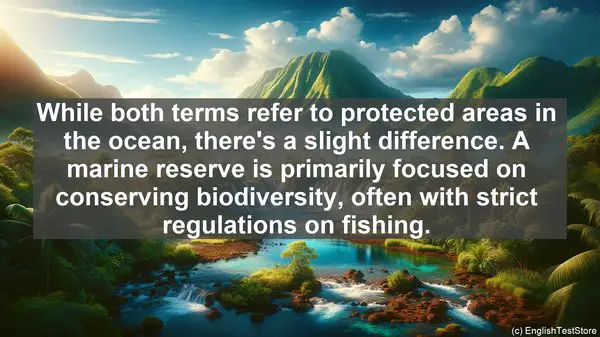Introduction
Today, we’re diving into the world of marine conservation. As we explore this fascinating field, it’s essential to grasp the precise meanings of certain words. In this lesson, we’ll unravel the top 10 commonly confused words in marine conservation, ensuring you have a solid foundation in the subject.
1. Marine Reserve vs. Marine Park
While both terms refer to protected areas in the ocean, there’s a slight difference. A marine reserve is primarily focused on conserving biodiversity, often with strict regulations on fishing. On the other hand, a marine park may allow certain activities like recreational diving, while still emphasizing conservation. Understanding this distinction helps us appreciate the diverse approaches to protecting our marine ecosystems.

2. Endangered vs. Threatened
When it comes to species conservation, these terms are crucial. Endangered species are at a higher risk of extinction, while threatened species have a lower but still significant risk. These classifications, determined by factors like population size and habitat loss, guide conservation efforts and legal protections. By correctly identifying the status of a species, we can prioritize conservation actions effectively.
3. Bycatch vs. Discards
In fishing, these terms relate to unintentionally caught marine life. Bycatch refers to non-target species, like dolphins or turtles, caught alongside the desired catch. Discards, on the other hand, are unwanted fish or other organisms that are thrown back into the sea, often due to size or market value. Both issues have implications for ecosystem health and sustainable fishing practices.
4. Marine Debris vs. Ocean Trash
While these terms may seem interchangeable, they have nuanced differences. Marine debris encompasses a broader range, including both human-made and natural materials, that end up in the ocean. Ocean trash, on the other hand, specifically refers to the human-made waste, like plastics and discarded fishing gear. Understanding these terms helps us address the sources and impacts of pollution more effectively.
5. Overfishing vs. Illegal Fishing
Overfishing occurs when the rate of fishing exceeds the natural replenishment of fish stocks, leading to population declines. Illegal fishing, as the name suggests, involves activities that violate fishing laws and regulations. While overfishing is a broader issue, encompassing legal and illegal practices, understanding the distinction is crucial for implementing effective management strategies.
6. Marine Sanctuary vs. Marine Monument
Both these terms refer to protected areas, but with different levels of permanence. A marine sanctuary is established through legislation, often with specific regulations. A marine monument, on the other hand, is designated by executive order and can have varying levels of protection. These designations ensure the preservation of important marine habitats and cultural sites.
7. Marine Ecology vs. Marine Biology
While these fields are closely related, they have distinct focuses. Marine ecology examines the interactions between organisms and their environment, including factors like nutrient cycling and food webs. Marine biology, on the other hand, is more centered on the study of marine organisms themselves, their behavior, and physiology. Both disciplines are vital for understanding and conserving marine ecosystems.

8. Marine Protected Area vs. No-Take Zone
A marine protected area (MPA) is a general term for any designated area with some level of protection. A no-take zone, as the name suggests, is a specific type of MPA where all extractive activities, such as fishing or mining, are prohibited. No-take zones serve as essential refuges, allowing marine life to thrive and replenish, ultimately benefiting adjacent areas as well.
9. Marine Mammal vs. Fish
While it may seem obvious, it’s important to remember that marine mammals, like dolphins or seals, are not fish. They are warm-blooded, have lungs for breathing air, and nurse their young with milk. Recognizing this distinction is crucial for understanding the unique conservation challenges and legal protections that apply to these fascinating creatures.
10. Marine Spatial Planning vs. Zoning
In the realm of ocean management, these terms relate to the allocation of space and resources. Marine spatial planning involves a comprehensive, integrated approach, considering various activities and stakeholders, to ensure sustainable use of marine areas. Zoning, on the other hand, is a more specific tool, dividing an area into designated zones with specific permitted uses. Both strategies aim to balance conservation and human activities in the marine environment.
